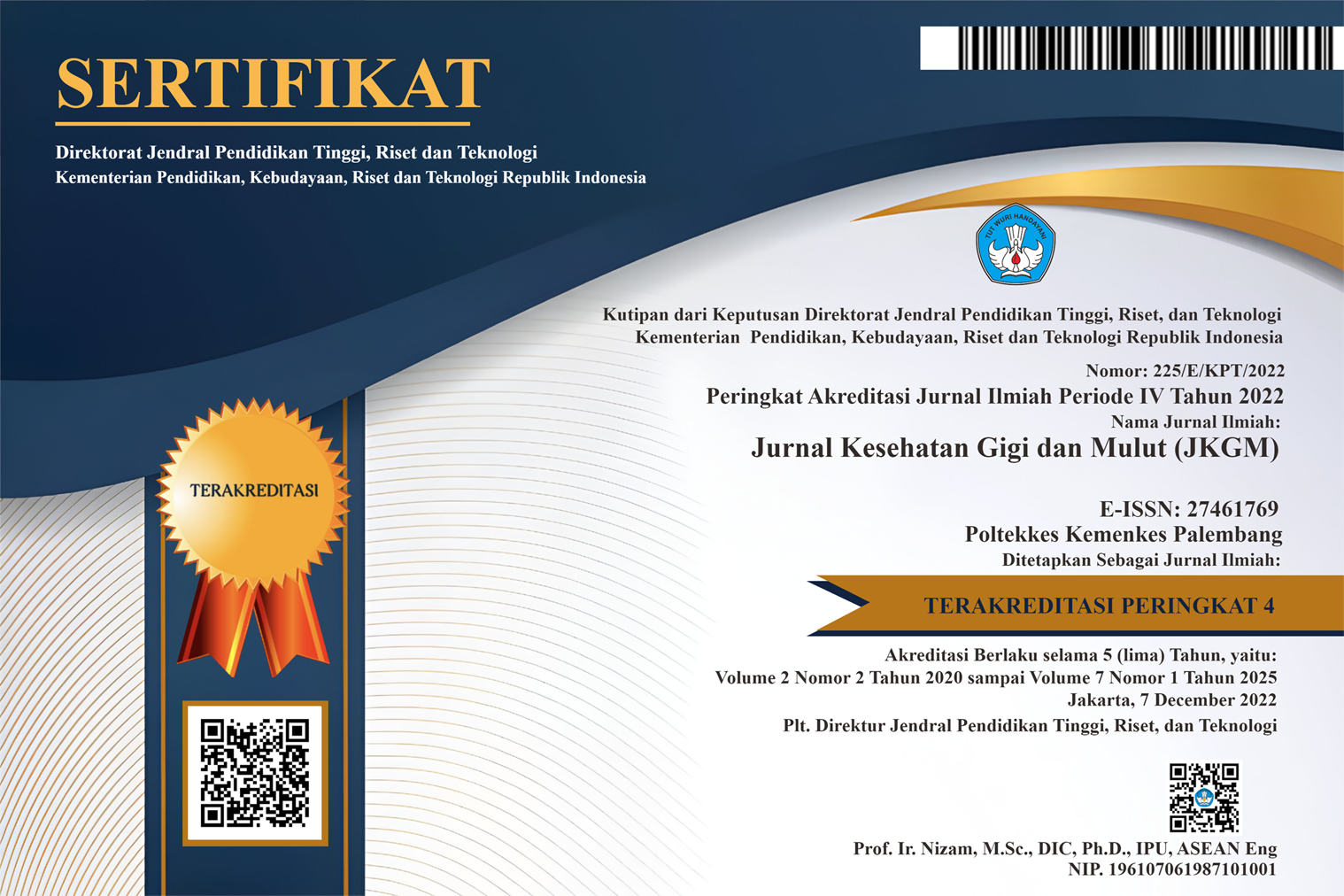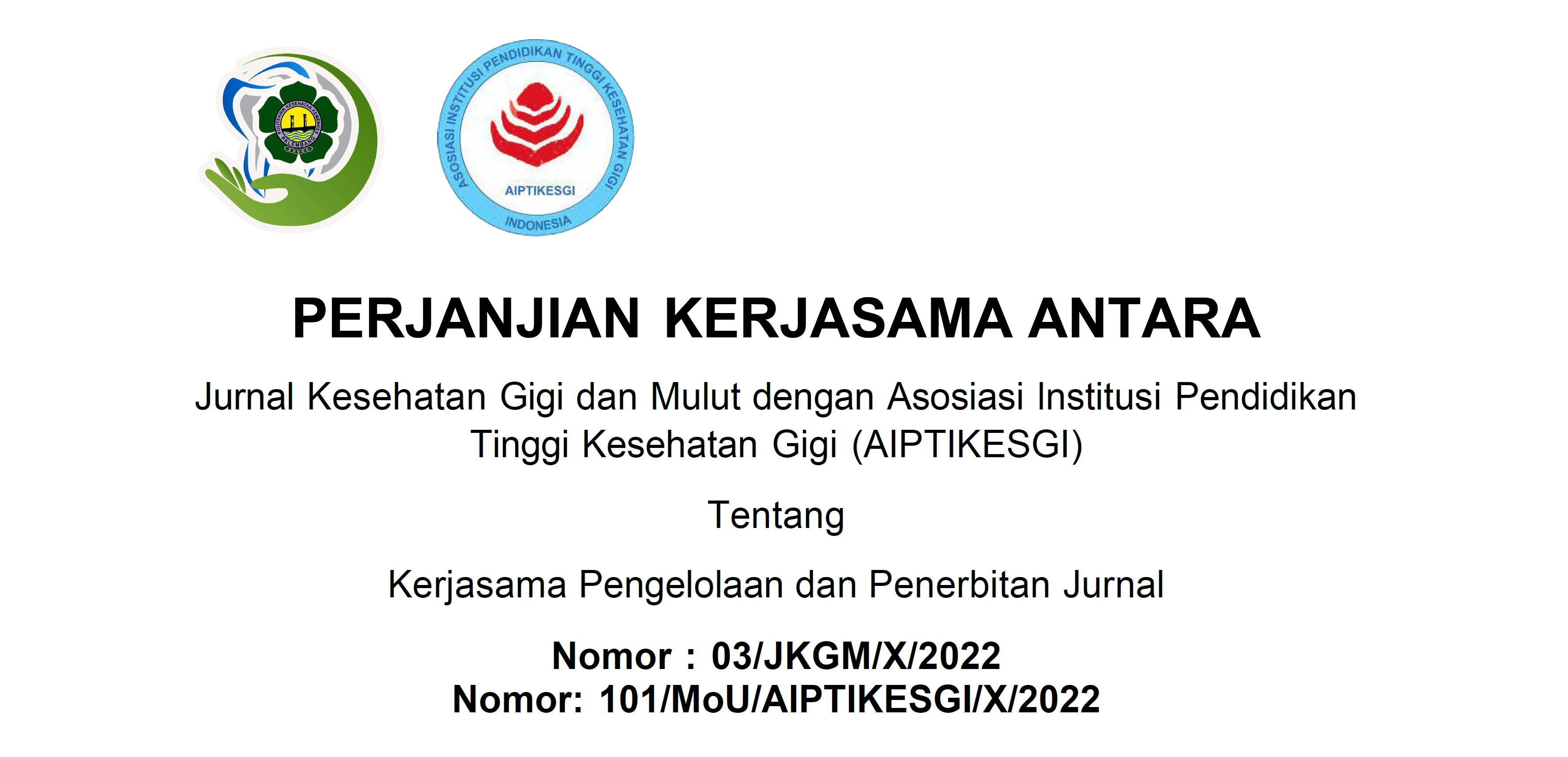Efektivitas Daya Hambat Ekstrak Mengkudu (Morinda citrofolia L.) terhadap Pertumbuhan Lactobacillus acidophilus: Studi in vitro
Abstract
Dental caries is a disease of the hard tissues of the teeth which until now cannot be cured. However, the process of worsening due to this disease can be anticipated by patching or removing it. Preventive measures against this disease must be able to intervene in at least one of the factors causing caries, one of which is Lactobacillus acidophilus. Noni fruit (Morinda citrofolia L.) which is an endemic plant in Indonesia, including South Sumatra, contains scopoletin which is bacteriostatic against Lactobacillus and can prevent the attachment of Lactobacillus acidophilus to the acquired pellicle on the tooth surface, thereby reducing the risk of dental caries. This research is an experimental study with a post test-only control group design. Noni extracts at concentrations of 20%, 40%, and 80% were tested for their inhibition on the growth of Lactobacillus acidophilus on de Man Rogosa Sharpe (MRS) agar media with 1% iodine as a positive control and 70% alcohol as a negative control. Data were analyzed using One-Way Anova test. Noni extract at concentrations of 20%, 40%, and 80% effectively inhibited the growth of Lactobacillus acidophilus with an average zone of inhibition of 7.2 mm, 8.3 mm, and 11.2 mm, respectively. Noni extract 80% was even more effective in inhibiting the growth of Lactobacillus acidophilus than the positive control.
References
2. Shitie A, Addis R, Tilahun A, Negash W. Prevalence of Dental Caries and Its Associated Factors among Primary School Children in Ethiopia. Int J Dent 2021;2021.
3. Ahirwar SS, Gupta MK, Snehi SK. Dental Caries and Lactobacillus: Role and Ecology in the Oral Cavity. Int J Pharm Sci Res 2019;10(11):4818–29.
4. Dixit LP, Shakya A, Shrestha M, Shrestha A. Dental caries prevalence, oral health knowledge and practice among indigenous Chepang school children of Nepal. BMC Oral Health 2013;13(1):1–5.
5. WHO. Oral health. Geneva, Switzerland: 2020.
6. Balitbang Kemenkes RI. Laporan Nasional Riskesdas 2018. Jakarta: 2019.
7. Karpinski TM, Szkanadkiewics AK. Microbiology of dental caries. J Biol Earth Sci 2013;3(1):21–4.
8. Kurniawan D, Widodo E, Djunaidi IH. The Effect of Noni (Morinda citrifolia) Fruit Meal as Feed Additive on Intestinal Microfloras and Villi Characteristics of Hybrid Duck. Bul Peternak 2016;40(1):34–9.
9. Kurniawan D. Aktivitas antimikroba dan antioksidan ekstrak tepung daun dan buah mengkudu (Morinda citrifolia). J Ilmu-Ilmu Peternak 2018;28(2):105.
10. Abou Assi R, Darwis Y, Abdulbaqi IM, Khan AA, Vuanghao L, Laghari MH. Morinda citrifolia (Noni): A comprehensive review on its industrial uses, pharmacological activities, and clinical trials. Arab J Chem 2017;10(5):691–707.
11. Hassanein EHM, Sayed AM, Hussein OE, Mahmoud AM. Coumarins as Modulators of the Keap1/Nrf2/ARE Signaling Pathway. Oxid Med Cell Longev 2020;2020.
12. Masadeh. Antimicrobial Activity of Common Mouthwash Solutions on Multidrug-Resistance Bacterial Biofilms. J Clin Med Res 2013;5(5):389–94.
13. Neeraja R, Anantharaj A, Praveen P, Karthik V, Vinitha M. The effect of povidone-iodine and chlorhexidine mouth rinses on plaque Streptococcus mutans count in 6- to 12-year-old school children: An in vivo study. J Indian Soc Pedod Prev Dent 2008;26(SUPPL. 5).
Copyright (c) 2022 Jurnal Kesehatan Gigi dan Mulut (JKGM)

This work is licensed under a Creative Commons Attribution-ShareAlike 4.0 International License.
Authors who publish with this journal agree to the following terms:
- Authors retain copyright and grant the journal right of first publication with the work simultaneously licensed under a Creative Commons Attribution License that allows others to share the work with an acknowledgement of the work's authorship and initial publication in this journal.
- Authors are able to enter into separate, additional contractual arrangements for the non-exclusive distribution of the journal's published version of the work (e.g., post it to an institutional repository or publish it in a book), with an acknowledgement of its initial publication in this journal.
- Authors are permitted and encouraged to post their work online (e.g., in institutional repositories or on their website) prior to and during the submission process, as it can lead to productive exchanges, as well as earlier and greater citation of published work















